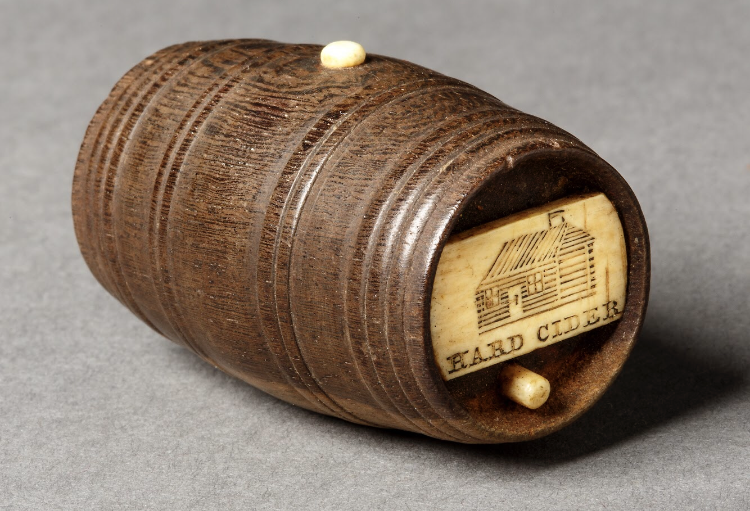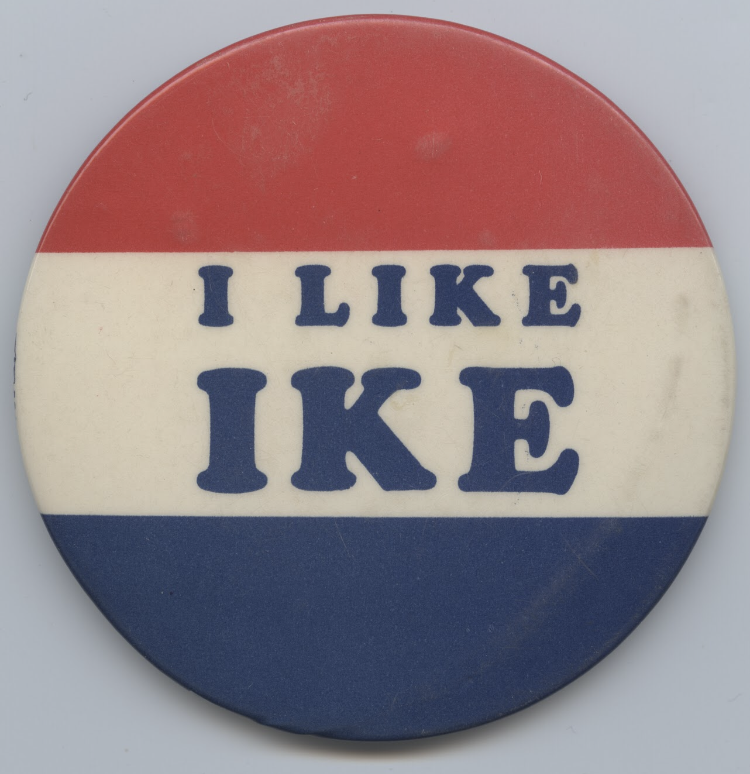Political Campaigns
Political campaigns are all about persuasion. Voters have a choice to make, and effective campaign materials can help candidates appeal to those voters.
Over the centuries, objects like silk ribbons, pin buttons, and lawn signs have been used to influence voters. They suggest the power of individual citizens to shape each other’s political opinions. Slogans and campaign materials might be created by the teams supporting each candidate, but their effectiveness depends on whether regular people wear them or share them.
The objects shown here were selected from an assortment of political campaign materials that were used and saved by Staten Islanders over the years. Some reflect local candidates and others represent famous national figures, but all are examples of common and popular ways of conveying political messages in the days before television and social media.
Campaign Novelty
1840
This miniature item, less than 2 inches long, is from William Henry Harrison’s campaign for U.S. President. Harrison was a general who led troops to victory at the battle of Tippecanoe in 1811, in the American Indian Wars. His 1840 political campaign became known in history as the "log cabin and hard cider campaign," portraying him as a populist folk hero. Harrison was elected, but died of pneumonia in April 1841, one month after taking office.
National Democratic Banner
Currier & Ives, publisher
1860
Stephen A. Douglas and Herschel V. Johnson were the Democratic candidates for President and Vice President of the United States in 1860, running in a four-way race against Republicans Abraham Lincoln and Hannibal Hamlin, Southern Democrats John C. Breckenridge and Joseph Lane, and Constitutional Unionists John Bell and Edward Everett.
Lincoln and Douglas had gained national attention two years earlier through the “Lincoln-Douglas Debates,” in which Lincoln challenged Douglas, the incumbent, for his seat in the Senate representing Illinois. A hotly debated topic was slavery in newly-formed states. Douglas favored an approach of popular sovereignty, in which each new state would decide whether or not to allow slavery, while Lincoln argued that “a house divided cannot stand” and union was all-important. Douglas won the senate seat in 1858, but Lincoln won the presidency in 1860.
Ribbon with Portrait of Abraham Lincoln
Isaac Dreyfus Sons, Switzerland
1861
This Swiss-made ribbon was likely a celebratory item made around the time of Lincoln’s first inauguration in 1861. Above the portrait is an eagle and banner motif with the words, “UNION FOR EVER.” The manufacturer of this item, a Swiss company, targeted American markets with ribbons that incorporated celebrity portraits from prints and the still-new medium of photography.
There were four candidates in the United States presidential election of 1860: Abraham Lincoln, Stephen Douglas, John Breckinridge, and John Bell. Lincoln won a decisive electoral victory and almost 40 percent of the popular vote nationwide. However, the majority of Staten Islanders favored Stephen Douglas in 1860 and George McClellan in 1864.
Campaign Token with Portraits of Ulysses S. Grant and Schuyler Colfax
1868
Republican Party nominee Ulysses S. Grant, who gained popularity for his skill as a general during the Civil War, won the 1868 U.S. Presidential election, along with his running mate Schuyler Colfax. Despite his administration being plagued by scandal, Grant was re-elected in 1872, but Colfax failed to win the nomination for re-election.
Campaign Kerchief with portraits of James A. Garfield and Chester A. Arthur
1880
Kerchiefs were popular campaign items from about 1850 to 1920. Supporters displayed them in homes and businesses and waved them in parades. This kerchief promoted the successful U.S. Presidential campaign of James A. Garfield, with Chester A. Arthur as Vice President. Garfield was assassinated only six months after taking office, and Chester A. Arthur served as President for the remainder of the term.
The origin of the phrase "The Union and the Constitution Forever," which appears twice in this kerchief design, is not known, but its earliest documented use is in a sermon in 1853. The phrase may seem familiar today because it has appeared as part of the backdrop on the stage of every U.S. Presidential debate since at least 1992.
Harrison & Reid Banner, Pleasant Plains, Staten Island
S.R. Barton, photographer
1892
The banner pictured here, with the slogan “For Home & Country,” lists the priorities of Republican candidate President Benjamin Harrison’s 1892 re-election campaign. Harrison lost the election to Grover Cleveland, the former President he had defeated four years earlier.
“I Like Ike” Pin Button
1952
“I like Ike” was the slogan for Republican Dwight D. Eisenhower’s 1952 campaign in the U.S. Presidential election. The slogan comes from a song written by noted composer Irving Berlin for Eisenhower’s campaign. The song was adapted from an earlier version that appeared in Berlin’s musical “Call Me Madam.”
Bumper Sticker, “Another Republican for Johnson”
1964
This bumper sticker and the attached pin buttons promote the 1964 Presidential campaign of Democrat Lyndon B. Johnson, with Hubert Humphrey as his running mate. Johnson defeated Republican Barry Goldwater in a landslide, winning 61.1% of the popular vote.








